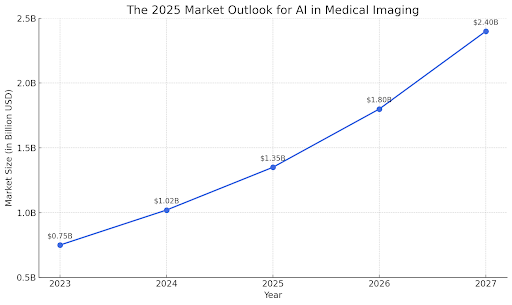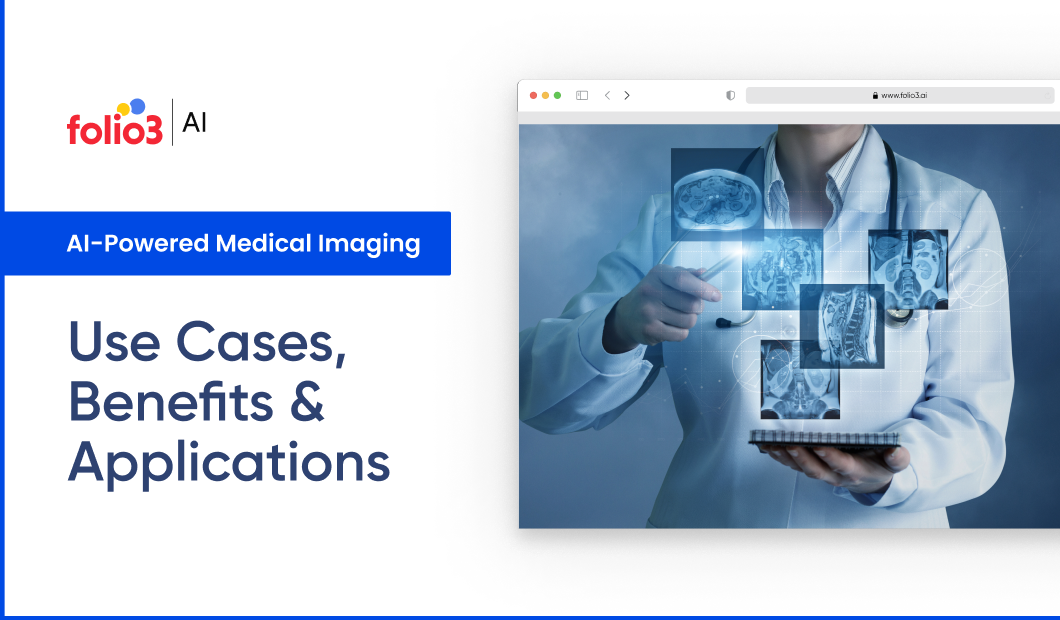Introduction
AI-powered medical imaging is making a real difference in healthcare. It helps with the field’s core activities and provides better, more accurate diagnoses. Plus, it fosters personal engagement with patients, allowing for tailored treatments for thousands of hospital individuals. The market for AI in medical imaging is rapidly expanding, driven by factors like the increasing volume of medical image data and government initiatives promoting its adoption.
As deep learning algorithms achieve remarkable precision, such as 98.56% accuracy in identifying brain tumors from MRIs and improving breast cancer detection rates by 20%, AI tools are setting new benchmarks for diagnostics. Beyond speed and accuracy, AI-powered medical imaging enables early detection of critical conditions, like detecting cardiovascular risks in X-rays, empowering clinicians to intervene before symptoms escalate.
Look how the top healthcare systems are progressively embracing AI-powered medical imaging solutions.
1. Mayo Clinic
Renowned for its medical expertise, the Mayo Clinic has been at the forefront of AI adoption. They use AI for medical imaging, early disease detection, and treatment planning.
2. Cleveland Clinic
Another leading healthcare institution, the Cleveland Clinic, has invested significantly in AI-powered medical imaging. They employ AI algorithms for various applications, including radiology, cardiology, and oncology.
3. Stanford Medicine
Stanford Medicine pioneered AI-driven healthcare, using AI for image segmentation, tumor detection, and radiation therapy planning tasks.
Read this article to explore the leading-edge use cases of AI-powered imaging, its benefits, and its growing impact on healthcare outcomes.
A Quick Glimpse of AI-Powered Medical Imaging in the Healthcare Industry
1. AI-powered medical imaging revolutionizes healthcare by enabling faster, more accurate diagnoses.
2. AI algorithms, trained on extensive datasets, can detect subtle patterns that human eyes may miss.
3. These tools offer objective assessments, such as measuring tumor size or blood vessel diameter, to aid clinical decisions.
4. The AI medical imaging market is projected to grow at a CAGR of 34.8% from 2023 to 2030, driven by rising data complexity and government support.
5. Developing AI tools involves multiple steps, including model building, validation, deployment, and regulatory compliance.
6. Essential features for AI tools include multi-modality support, transparency, advanced processing capabilities, and smooth workflow integration.
What is AI-Powered Medical Imaging
Healthcare is dealing with some serious challenges, and AI-powered medical imaging really helps out. With thousands of scans being done every day, waiting for a diagnosis can be a huge issue. Patients might be suffering from severe diseases and require quick scans for treatment. However, now, with AI for medical imaging, these scans are analyzed in seconds, making it so much easier for radiologists to diagnose and treat patients quickly. Further, diseases like cancer, heart issues, and neurological disorders can be detected earlier, which can save lives and improve patient outcomes. Plus, this technology also helps manage the high demand for imaging services and reduces the chances of human error in diagnoses.
The 2025 Market Outlook for AI in Medical Imaging
What sets AI-powered imaging apart is its ability to complement radiologists, transforming their role from image interpreters to strategic care partners in multidisciplinary teams. As medical imaging evolves from subjective analysis to an objective science, healthcare professionals can deliver faster, more personalized care while focusing on tasks that truly add value.
The AI-powered medical imaging market is on track to grow fast, reaching $1.35 billion by 2025. What’s driving this? It’s all about advancements in machine learning, more healthcare providers using AI tools for diagnostics, and the increasing need for quicker, more accurate solutions in healthcare. The primary key factors contributing to this growth include the rising volume of medical imaging data, government support for AI integration, and the focus on reducing radiologists’ workload.
Not only this, AI’s role in early disease detection, personalized treatments, and workflow optimization is pivotal in transforming modern healthcare systems.

Current Challenges Faced by the Healthcare Industry
1. Data Overload and Interoperability Issues
With the rise of electronic health records (EHRs) and digital tools, healthcare providers are drowning in complex patient data. The problem is that many systems don’t work well together, making integrating and sharing information across platforms hard. This lack of interoperability leads to inefficiencies, delays in care, and fragmented patient records, which affect decision-making and patient outcomes.
2. Staffing Shortages and Burnout
The healthcare industry has limited resources of skilled professionals, including nurses, physicians, and radiologists. This is compounded by high burnout rates, driven by long working hours, administrative burdens, and mental stress from patient care. Staffing challenges not only diminish the quality of care but also amplify wait times and compromise patient safety.
3. Rising Costs and Limited Access to Care
Healthcare systems are struggling with escalating operational costs due to expensive medical technologies, drug prices, and infrastructure needs. Hence, many regions still lack access to essential healthcare services, leading to disparities in care. The financial burden on patients and healthcare providers alike makes it critical to adopt cost-effective innovations without compromising care quality.
Use Cases of AI-Powered Medical Imaging
1. Early Detection of Tumors
AI algorithms are multifaceted and initially detect symptoms of tumors by analyzing subtle patterns in MRI and CT scans that might escape human observation. Detecting diseases early improves outcomes by supporting timely care, especially in cases of lung, brain, and breast cancer.
2. Automated Interpretation of X-Rays
AI-powered tools can interpret chest X-rays and identify signs of conditions like pneumonia, tuberculosis, and fractures with speed and precision. These tools help radiologists prioritize critical cases, especially in emergency settings, reducing diagnosis time from hours to minutes.
3. Personalized Treatment Planning
AI in medical imaging assists in creating personalized treatment plans by analyzing patient scans and predicting responses to different treatments. For example, AI tools can assess tumor size and its likely progression, guiding oncologists in choosing optimal chemotherapy or radiation therapies.
4. Enhanced Cardiovascular Imaging
AI-powered imaging solutions help detect heart conditions like atrial fibrillation or arterial blockages from echocardiograms and angiograms. By providing detailed analysis, these tools support cardiologists in making precise decisions and planning interventions like stenting or surgeries.
5. 3D Image Reconstruction for Surgery
AI algorithms can convert multiple 2D scans into 3D models, giving surgeons a detailed view of organs and structures before performing complex surgeries. These 3D reconstructions improve surgical planning and reduce risks by providing better visualization of patient anatomy.
Benefits of AI-Powered Medical Imaging
1. Discovery of Hidden Biomarkers
AI can detect subtle, previously undetectable biomarkers in medical images, revealing insights into diseases at pre-symptomatic stages. This empowers early intervention, even before symptoms manifest, improving treatment outcomes.
2. Real-Time Collaboration Across Geographies
AI-powered imaging systems allow instant sharing and analysis of scans globally. Specialists in different regions can collaborate in real-time on complex cases, ensuring patients receive expert opinions without delays.
3. Adaptive Learning for Continuous Improvement
AI systems improve over time by learning from new datasets and user feedback. This adaptive capability ensures that technology evolves with emerging medical knowledge, stays relevant, and enhances diagnostic precision.
4. Radiomics-Driven Precision Medicine
AI in medical imaging employs radiomics, extracting vast amounts of quantitative data from medical images. This information helps in tailoring hyper-personalized treatments, such as predicting patient-specific responses to chemotherapy.
5. Reduction in Radiation Exposure
AI reduces the need for repeat imaging by providing highly accurate initial diagnoses minimizing patient exposure to radiation. Additionally, AI-driven algorithms help optimize scan protocols, ensuring safer procedures without compromising diagnostic quality.
Applications of AI-Powered Medical Imaging
1. AI-Enhanced MRI for Neurodegenerative Disorders
AI tools analyze MRI scans to detect early signs of diseases like Alzheimer’s or Parkinson’s, identifying minute changes in brain structure that are imperceptible to radiologists. This enables proactive management and personalized care plans.
2. Automated Fracture Detection in Emergency Rooms
AI-powered X-ray analysis systems assist ER physicians by instantly detecting fractures, especially in complex regions like the wrist or spine. This reduces diagnostic delays and ensures timely treatment for trauma patients.
3. AI-Assisted Breast Cancer Screening
AI algorithms enhance mammogram accuracy by identifying microcalcifications and subtle tissue changes, improving early breast cancer detection rates. This reduces false positives and unnecessary biopsies, streamlining patient care.
4. Predicting Cardiovascular Risk with Chest X-Rays
AI analyzes chest X-rays to assess cardiovascular health, identifying indicators such as artery calcification or heart enlargement. This helps in predicting conditions like heart failure or stroke, promoting timely interventions.
5. Precision-Guided Surgery with AI Imaging
AI-powered imaging tools provide real-time guidance during surgeries, highlighting critical structures like blood vessels or tumors. This ensures higher surgical accuracy, minimizes risks, and improves post-operative recovery.
How FOLIO3 AI Is Enabling Healthcare Organizations With Its Medical Imaging
Healthcare has always been an industry that requires prompt workflow, often operating under time-sensitive conditions. In the 2025 landscape, with the rise of complex diseases, the demand for AI-powered medical imaging solutions is becoming paramount.
We offer comprehensive AI offerings for healthcare to manage their hectic routine, 99% accurate scans, and better patient care. Our dynamism AI-powered medical imaging accelerates and ensures diagnostic accuracy, minimizing wait times and equipping healthcare professionals with reliable insights to make informed decisions effectively.
Benefits of Folio3 AI-Powered Medical Imaging
1. Accelerating Medical Image Analysis with Computer Vision
Using computer vision techniques, Folio3’s solutions analyze medical images to detect patterns and anomalies quickly. Radiologists can create detailed studies, track metrics, and diagnose patients with greater accuracy and speed, minimizing the chances of human error.
2. Predictive Analytics for Better Care Decisions
Folio3 AI l patient records from EHRs and EMRs, using machine learning algorithms to extract valuable insights. This enables healthcare providers to predict patient needs and optimize treatment plans, improving outcomes and more personalized care.
3. Improving Diagnostics and Clinical Trials
Our AI solutions speed diagnostics and make clinical trials more efficient by automating processes and integrating Real-World Data. This allows for frictionless merging of trial phases and the development of patient-centered endpoints, accelerating innovations in treatment.
4. Real-Time Patient Monitoring for Optimal Care
Our AI systems empower healthcare providers with real-time monitoring of patient movement, environmental conditions, and staff workflows. This real-time data helps optimize resource allocation, ensuring high-quality care at every step.
Partner with Folio3 AI to Supercharge Your Diagnostic Processes
Folio3 AI’s expertise in medical imaging and healthcare solutions empowers organizations to overcome challenges like manual data handling, legacy infrastructure, and interoperability issues.
By integrating our proficient AI tools, healthcare providers can speed up diagnostics, automate workflows, and improve patient care at scale. Contact us today to explore how Folio3 AI manages your healthcare operations and elevates patient outcomes.
Conclusion
AI-powered medical imaging represents a fundamental advancement in the field of healthcare. It uses deep learning models to analyze imaging data, AI expertise diagnostic accuracy, facilitates timely decision-making, and supports healthcare professionals in their clinical workflows.
While challenges such as data privacy, algorithm bias, and the need for regulatory oversight exist, the potential benefits of improved patient outcomes and increased efficiency are significant. As technology continues to evolve, AI-powered has the potential to redefine medical imaging and contribute to a more effective healthcare system.
Frequently Asked Questions (FAQs)
The benefits of using AI in medical imaging are:
– Accurate and Efficient Diagnosis
– Improved Treatment Planning
– Faster Image Analysis
– Reduced Error Rate
AI-powered imaging algorithms can
– Analyze medical images at speed
– Reduce diagnostic errors
– Assess large volumes of medical images
– Contribute to personalized medicine.
One of the major challenges that exist in AI medical imaging is data quality and bias. AI algorithms learn from data-biased or incomplete datasets, which might lead to inaccurate outputs.

Dawood is a digital marketing pro and AI/ML enthusiast. His blogs on Folio3 AI are a blend of marketing and tech brilliance. Dawood’s knack for making AI engaging for users sets his content apart, offering a unique and insightful take on the dynamic intersection of marketing and cutting-edge technology.










